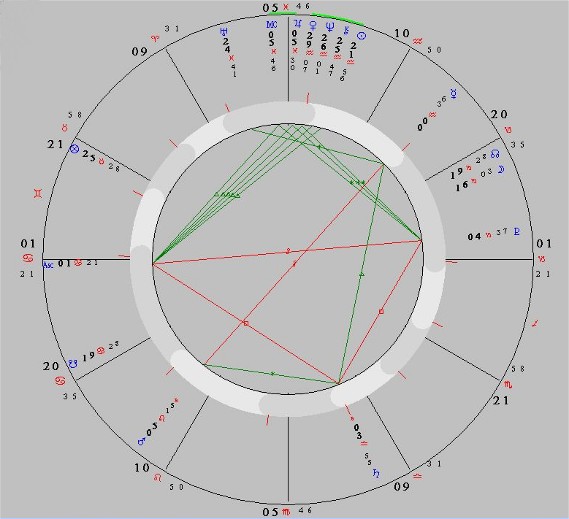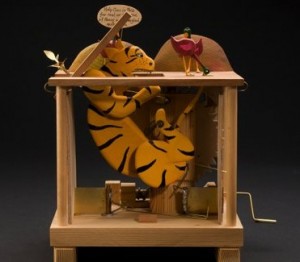EYES TO SEE WHAT IS
Feb 12th, 2010 by admin
A Science Lesson in an Art Museum
The Sun moves into a different sign of the zodiac every month, giving us twelve opportunities in a year to observe a zodiacal sign in its truest expression, yet most of us sleep through what could be one of the richest experiences of our lives. Why?—because we have not trained our eyes to see.
Every person who possesses a basic, even very limited, understanding of astrological concepts can be observant of how a sign’s characteristics “shine forth” in all facets of our lives during the month when the Sun enters that sign’s thirty-degree segment of the heavens. What kinds of things happen right under our noses during these 30 +/- days that give testimony to a divine order of existence?
We may begin with the seasons, since the tropical zodiac is measured by the earth’s revolution around the great orb of the Sun. Without fail, there will be seasonal phenomena to observe. How can we not notice that it snows and blows cold in January/Capricorn in the northern latitudes, but it does not snow in July/Cancer? In the southern hemisphere it’s the opposite, but in both hemispheres summer and winter solstices bring extremes of climate. Similarly, as a sign and its opposite differ, they also share many of the same qualities. Cancer and Capricorn are water and earth signs, respectively, that share a cardinal modality. While one hemisphere has summer the other has winter, but both are cardinal by sign and both at extremes of climate.
Although astrologically we often associate properties and phenomena with seasons, as determined by the inclination of the earth on its axis, neither these seasons, nor this inclination, nor the phase of the Moon, can be the single “causative determinant” of happenings on earth. Other overall “causative” agents, including sidereal and planetary influences, are the broader, more far-reaching “seasonal” or cyclic producers (not necessarily causes) of effects. We must remember the hermetic axiom, “as above, so below; as below, so above” in all of its inclusive and exclusive implications—or from a 360° perspective, as without – so within; as within – so without, while we discriminate between correlation and cause.
Phenomena (noteworthy developments) more subtle than seasons occur with somewhat the same predictability as seasons, and we can observe them if we are big enough and smart enough to see. First, we memorize a few keywords, open our eyes, and engage our minds (and hearts). Second, we look impartially in every direction to observe manifest “causes and consequences” (actually evidential correlations) of the forces or energies, both obvious and subtle, in our daily lives and in the world around us.
In terms of the heavenly bodies, we associate those closest to the earth and closest to our Sun with very observable or obvious (yet transitory) phenomena. The more distant heavenly bodies, those we consider to be transcendental, usually produce more subtle (yet profound) manifestations.
With that introduction in mind, please join me as I meet a friend for lunch and a visit to the Chazen Museum of Art.
She and I had our choice of tables, and we chose one by the sunny window with a view of the rushing traffic and the travelers on foot. Much to our surprise, our waiter explained that the restaurant would be closing its doors permanently at the end of this very day. Truly—this was an opportunity that if not taken would never have returned. The pizza was delicious—the conversation both serious and light-hearted and all of it absorbing enough to cause us to nearly forget that the next thing we had agreed to do was visit the art museum.
As we left the lame-duck restaurant, we walked in the cool wintry air briskly past an eclectic array of shops along State Street, the mile-long route between Capitol Square and the University of Wisconsin campus. Once a thoroughfare, but in recent decades a limited-access pedestrian mall, it took us to the newly-named Chazen Museum of Art. Currently under construction to double its size, the protective barriers that we encountered forced us to reconsider our approach, but we soon found one of its two main entrances accessible and entered into the welcoming warm airy expanse.
What will we see that is new? Filled with the wonderful spontaneity (her Aries Sun and my Aries Moon) of Sunday’s decision to visit the museum, we eagerly read the posting of the current traveling exhibit, “Contemporary Mechanical Sculpture.” … ???… Well, that took the air out of my balloon. “That doesn’t sound very appealing,” I said. Nevertheless, Aries Sun led the way, eager to find out about machines while I at least enjoyed being in close proximity to renaissance, post renaissance, and modern paintings and real sculpture.
The exhibit drew us in and much to my surprise delighted and entertained us so thoroughly that it left us with only a little time and inclination to visit the museum’s other collections. The exhibit’s brochure informed visitors:
While on vacation in 1989, metal-smith Michael Croft wandered into a dimly lit arcade in London’s Covent Garden district. He was greeted by a life-sized moving skeleton.……then.found himself surrounded by an idiosyncratic group of finely crafted mechanical sculptures that sprang into action at the turn of a crank. These devices, made of wood, wire, tin, and paint, plus various configurations of cams, gears, and ratchets—perform absurd and witty acts. An altered reality comes alive, one where chickens test evolutionary theories, tigers experience writer’s block, and Icarus catches himself flying too close to the sun with his zipper undone.
There’s more: A “Man Drinking in the Moon,” “Levitation on Stool” (without strings or wires), and a Turtle on a Fencepost.
In my favorite: “Great Tongue From Above” by Neil Hardy, an anteater pokes its long tongue into the subterranean tunnels of an ant hill, and the little ants (made from silver wire), unaware of the tongue’s source, think it’s an angry god they must appease with brandy and cognac. As the crank turns, the ant characters—Prophet of The Tongue, The High Priest, and Keeper of the Bucket, to name a few—scurry about. One lowly ant offers intermittent cups of libation, saving them all from destruction.
By popular acclaim, the piece de resistance: “The Flasher,” entertains shamelessly. Seeing a bald guy in tennis shoes and a trench coat, you wonder ……??……….and you’re willing to find out, so as he opens the flaps of his coat, you look, and a blinding flash startles your eyes. If you dare to stare, you’ll discover it comes from a little camera, strategically placed. You can see a video clip of The Flasher in action on the Chazen Museum of Art’s website. It requires QuickTime player, and you can download that by following the prompts.
http://www.chazen.wisc.edu/exhibitions/Automata_video_clips.htm
Whimsical, zany, thought-provoking curiosities, the mechanical sculptures that were too delicate to run constantly, the Chazen showcased in big acrylic-glass boxes. Video monitors displayed the movements and machinations of each.
On the date of our expedition, February 10, 2010, we had met a few minutes after 1:00 p.m. Not only was the Sun in Aquarius, but Mercury, Neptune, Chiron and Venus were also in the sign of the water bearer. These planets had culminated at the Midheaven and were in the ninth house of higher education. Uranus, the ruling planet of Aquarius was rising in the tenth. Although we didn’t plan it this way, and it is only now noted, astrological indicators could not have been much better for such an outing. Only in retrospect did I realize the value of these moments for finding Aquarian principles in a very ordinary experience. Let’s take a look at Aquarian keywords, and the Sun’s, to determine if they describe the adventure.
The Sun: individuality, what one really is, vitality, will, chief ambition, those in authority, men.
Nature of the sign, Aquarius: Air = intellectual and social. Fixed = stable.
Basic keywords for Aquarius: humanitarianism, science, new systems, corporations, universality, universal friendship
Basic keywords for the ninth house: higher mind, religion, law, long journeys.
Keywords for Aquarius’ ruling planet, Uranus: The Awakener, altruism, inventiveness, originality, sudden action, unconventionality
Keywords for Aquarius’ co-ruler, Saturn: contraction, persistence,caution.
Keywords for the other planets in Aquarius:
Mercury: reason, self-expression, speaking, writing, gestures
Venus: attraction, cohesion, coalition, personal love, social instincts and activities, art ornamentation, beauty.
Neptune: superphysical entities, divinity, occultism, knowledge from sources above reason (entities)
It’s possible to find many more valid keywords, but for brevity, only the basic keywords from the RF’s Astrological Keyword System are given.
For universality, my friend and I are from different cultures, and we were enjoying that which can be universally enjoyed and appreciated by almost anyone. Leo, the sign opposite from Aquarius, rules children and creative play. As it turned out, the mechanical sculptures were nothing if not playfully whimsical. Uranus keywords, Inventive, original, and unconventional thoroughly describe the exhibit.
Uranus in the tenth house put Aquarius’ ruling planet in the house of profession, standing in the community, and the father. In the sign, Pisces, it carries the characteristics of that sign, sensitivity to superphysical influences, sense of unity with all life, mysticism, and ripe destiny. There was definitely other-worldly quality in the themes of the mechanical sculptures. At the same time they were relevant to the common universal experiences of life. The ninth house position of most of the planets indicates the higher mind and religion (The Tongue From Above).
Furthermore, the planets Uranus and Neptune are in mutual reception. This means that each lends its qualities to the other in mutually beneficial ways. Interestingly, a negative keyword for Uranus is licentiousness, and it applies in a gentle way to a favorite of the show, The Flasher. Other Aquarian concepts also fit. The unexpected surprise and the flash of light represented the sudden revelation or idea of the inventor, and the housing in glass was representative of the glass house of Aquarius.
Aquarian truth shone throughout the entire experience, as all mechanics were exposed and nothing was shielded, that is, with the exception of that camera, and this was simply Uranus working in concert with a Neptunian sense of propriety. We associate Aquarius with truth and forthrightness, even with the potential to be shocking or ill-received, but Pisces brings hidden qualities and a veil of secrecy, just as the Piscean Age, brought the Chistian era with the idea that some things must yet remain hidden. Pisces rules film and the cinema, so it follows that the camera would be the second veil after the trench coat.
Could there have been a better representation of the sign of Aquarius? As we notice four planets in that sign in the ninth house and the ruler of Aquarius in Pisces in the tenth, we marvel at how the universe gifted us with an exceptionally prime example and say “Glory be to God in the highest !” Saturn, or father time, the keeper of the clock, is the co-ruler of Aquarius, and like most things Aquarian, the experience came as an opportunity that, if not taken, would never return. 


nice post. thanks.